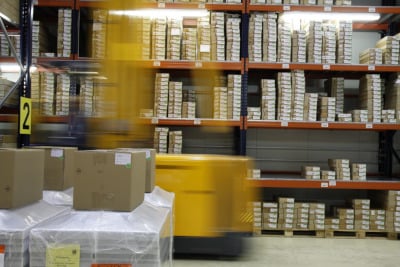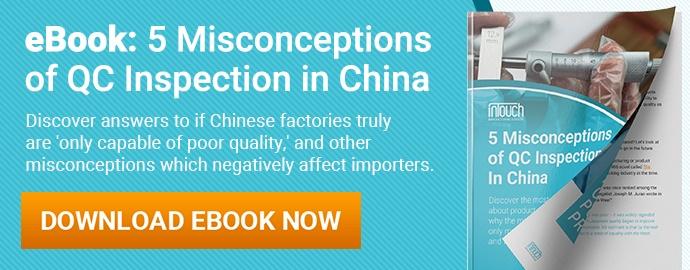Best in Manufacturing – April 7, 2019
Each Sunday, we publish a list of top articles and other content related to manufacturing in areas like quality control, product development, supply chain management, sourcing, auditing and law.
1. China’s small factories are losing business, despite tax cut
Chinese officials announced last month that they will cut the value-added tax (VAT) rate for manufacturing firms by 3 percentage points to 13 percent. The move is aimed at offsetting China’s economic slowdown by boosting domestic business and aiding employment.
But for small factories in China, the tax cut might be too little, too late.
Small manufacturers say the tax cut doesn’t do enough to improve China’s slowing business climate. China’s annual GDP growth has been steadily declining since 2010 when it last recorded over 10 percent growth. The Chinese economy grew only 6.6 percent in 2018, the lowest increase in 28 years.
As Yang Senping, a professor at Jinan University, says:
When the economic situation is very bad, even if the tax reduction is comprehensive, companies do not dare to expand or employ [more] people.
China is only aiming for a 6.0 to 6.5 percent growth rate in 2019, meaning the economy is likely to continue to slow this year.
Can small manufacturers survive in this new age of slower economic growth? China’s government will have to ask itself how far it’s willing to go to protect these small businesses during the economic slowdown.
“No profit at all from the production process”
Slowing market demand is a pressing problem facing small manufacturers, particularly in labor-intensive industries like garments and textiles.
The reaction from small manufacturers following the announced tax cuts is that their profit margins are already so small that the tax cuts are of little help. Rather, the tax cut is more likely to help larger manufacturers with annual output valued at more than 50 million yuan.
Many smaller manufacturers rely on tax rebates for export orders to stay afloat. As one Guangdong garment factory owner, Steve Liu, said:
Do you know why we still prefer the export orders? Because there is no profit at all from the production process. What we earn is the export tax rebate of between 11 and 13 percent. It’s an open secret in the industry.
Liu recently turned down a large order because the offer of $4 (26.86 yuan) per pair of pants was below the 29.3 yuan production cost before tax. And he’d need to employ more workers to produce the order, which is becoming increasingly difficult with rising labor costs.
China recently raised tax rebate rates by one to five percentage points to boost sales during the trade war. But many experts say this rebate-driven profit model is already unsustainable with a slowing economy and rising labor costs.
High-tech manufacturers receive more government support
Aside from slowing market demand, private-owned small businesses are also complaining of a lack of credit from the Chinese government.
It’s generally more difficult for private small businesses to get loans from central banks than state-owned firms. And those private firms that do manage to get loans usually face a higher interest rate. While China has taken steps to boost lending, banks still view state-owned companies as lower risk than private companies.
The Chinese government has also favored granting more funding to companies in high-tech industries in recent years, as part of a long-term pivot towards high-tech manufacturing.
The new tax cut won’t benefit high-tech industries—but that’s because they already enjoy better tax benefits. The VAT rate for high-tech companies is already set to 3 percent, far below the new national rate of 13 percent.
Small businesses in “undesirable industries” like garments and textiles can only dream of such low tax rates for now.
Are you working with a small manufacturer in China? Follow the link below to learn more about the challenges facing small manufacturers during the economic slowdown.
China’s ‘unprecedented and sufficient’ tax cut still does not do enough for small manufacturer, owners say – He Huifeng, South China Morning Post
2. Registering trademarks in China: the basics
China’s courts processed 40 percent more intellectual property cases in 2018 than in 2017. And China just reformed its foreign investment laws to better protect foreign IP and address U.S. concerns amidst the trade war.
But that doesn’t mean importers can just sit back and relax now when manufacturing in China.
Registering your trademark in China is one of the most crucial first steps you can take to protect your brand in China.
China follows a “first to file” trademark system, meaning whoever files the trademark first owns the trademark, regardless of whether they were the first to use it. So you can actually be sued for using your own brand name by trademark squatters in China!
Registering your trademark isn’t a walk in the park—registering your trademark will likely take up to two years. But the alternative is facing years of brand devaluation and court cases with trademark squatters, counterfeiters or grey market suppliers.
Start two years in advance to register your trademark
The process of registering a trademark can take up to 15 months from the date of filing to preliminary approval and publication.
The process generally includes:
- Filing the application: File an application with the China Trade Mark Office (CTMO) or the World Intellectual Property Organization (WIPO).
- Choosing product and service subclasses, if applying through CTMO: Be sure to register all relevant subclasses for your business—for instance, “shoes” and “boots” fall into separate classes. A trademark can be registered by separate companies in different categories.
- Registering the trademark in Chinese characters: Your same or similar trademark can be registered in Chinese characters by another business if you don’t register it first.
Without a registered trademark, you’ll face difficulties holding companies accountable that infringe on your IP in China.
A registered trademark is necessary to compel Chinese ecommerce platforms to remove listings of counterfeit or knockoff of your products, for instance. Most of these platforms require you to provide proof of IP ownership to even submit a request to remove an infringing product.
Creating your Chinese brand name
Many importers mistakenly think if they register their trademark in Roman characters, they don’t need to register their trademark in Chinese too. But registering your trademark in Chinese characters can provide greater protection against your brand and help improve brand visibility in China.
So can you just plug your brand name into Google Translate? Not really. You might make the mistake Coca Cola first made in China where their trademark translated as “bite a wax tadpole” (蝌蚪啃蜡)—hardly the sort of name you’d associate with a refreshing beverage.
There are three different ways importers might choose to translate their trademark into Chinese:
- Literal translation: Translate the literal meaning of your brand name. For instance, Apple has trademarked the Chinese word for “apple”, “Ping Guo” (苹果).
- Phonetic translation: Create a Chinese character name that sounds like the original/Roman character trademark. For instance, McDonald’s is known as “Mai Dang Lao” (麦当劳).
- Combined literal and phonetic translation: Reference both the sound of the Roman name and either a defining characteristic of your brand or a positive Chinese cultural reference. For instance, BMW is known as “Bao Ma” (宝马), meaning “precious horses” in Chinese.
As you can see, it’s not as simple as just translating your brand name into Chinese. You’ll probably want the help of a native Chinese speaker in determining the appropriate translation.
Don’t roll the dice when it comes to Chinese trademarks, despite improving regulation. Follow the link below to learn more about trademark protection in China.
China’s Trademark Regime: How to Protect Your Brand in the Mainland – Melissa Cyrill, China Briefing
3. Are you sending your products into a retail black hole?
At Adidas’ pop-up “Storefactory”, customers could design and buy a custom garment produced in-store by automated knitting machines in just four hours.
 Compare that with manufacturing a product months in advance, just for it to sit on a shelf unsold until it’s relegated to the clearance rack.
Compare that with manufacturing a product months in advance, just for it to sit on a shelf unsold until it’s relegated to the clearance rack.
When supplying products to major retail outlets, it can sometimes feel like you’re sending your products into a black hole. Most manufacturers rely on pre-digital production and retail processes, which make it difficult to identify customer needs and subsequently offer customers better choices.
This pre-digital black hole leads to two main problems in order fulfillment:
- Excess inventory of goods that customers don’t want, leading to discounts to get rid of them
- Insufficient supply of the products that customers do want, leading to stockouts at retailers
Digital fulfillment is the integration of offline and online manufacturing and retail fulfillment channels into one digital strategy. And it might be just what your supply chain needs to eliminate fulfillment bottlenecks and realign decision making with customer needs.
What do your customers really want?
With pre-digital retail strategies, there’s an informational disconnect between manufacturing operations and the customer experience in the store.
Not all customers are alike. Some customers want to be able to visit a store to pick up a product on their way home from work. Others would prefer the product was waiting for them on their doorstep when they get home.
This featured article lists three main questions customers ask when choosing a product:
- Are my desired product attributes present?
- Is the price point acceptable?
- How long will it be until I receive the product?
Consumers are often willing to make tradeoffs between the different choices to best meet their needs. For instance, they might be willing to pay more for a product if they’ll receive it faster.
But many manufacturers and retailers fail to provide consumers with the flexibility to weigh these options. They simply offer what is in stock, rather than what the customer actually wants. Your supply chain should be aligned instead to provide customers with options that best fit their priorities, not yours.
The authors of this featured article studied one automobile manufacturer whose manufacturing operations couldn’t keep up with high-demand vehicles. Rather than simply saying the vehicle was out of stock, they gave customers a choice. Customers who were willing to wait were offered a discount and the ability to customize the precise vehicle they wanted in return.
And it worked. This strategy allowed the company to capture demand that only their competitors would previously have been able to meet.
Implementing a digital fulfillment strategy
So how do you digitize your fulfillment strategy to better meet your customer needs?
The authors have a few different suggestions:
- Explore new technologies that make it economical to manufacture a variety of products in small quantities and from different suppliers, such as 3D printing
- Enhance information flow so that the full spectrum of choice is visible to your customers, including the tradeoffs among options
- Integrate manufacturing and retail operational and financial information into one IT system to establish a common data infrastructure
With a pre-digital strategy, you have little visibility into the customer’s actual decision-making processes when buying your product. Digital fulfillment offers manufacturers the opportunity to manufacture the product their customers want, when they want it.
Follow the link below to learn more about how digital fulfillment might help shine a light on your customer’s decision-making processes.
How Digital Fulfillment is Changing Manufacturing – Matthias Holweg, Benn Lawson and Frits K. Pil, Harvard Business Review
We’re constantly scanning the web for top manufacturing stories and news. If you’d like to submit an article for consideration for our weekly Best in Manufacturing, send us a message and let us know.







